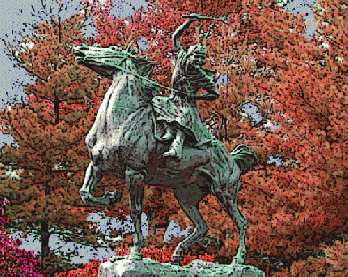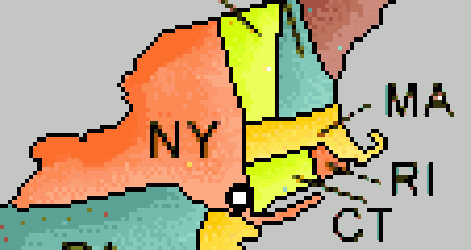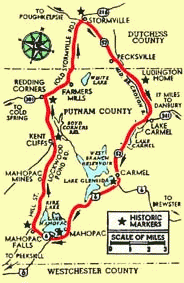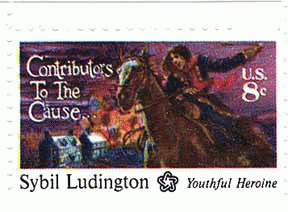| Back OpEd News | |||||||
|
Original Content at https://www.opednews.com/articles/The-Midnight-Ride-of---S-by-Meryl-Ann-Butler-110418-51.html (Note: You can view every article as one long page if you sign up as an Advocate Member, or higher). |
|||||||
April 18, 2011
The Midnight Ride of ... Sybil Ludington
By Meryl Ann Butler
Sybil Ludington was from New York's Duchess County. She was younger and braver, but much less famous than Paul Revere. And unlike Revere, she did not have the support of other riders. In 1777, her courageous midnight ride may have single-handedly changed the course of American history. Why don't we know more about her?
::::::::

Sybil Ludington, statue by Anna Hyatt Huntington (color added)
(Image by Wikimedia (Anthony 22)) Details DMCA
April 18th was my grandmother's birthday, which was why she often regaled us grandchildren with a retelling of Henry Wadsworth Longfellow's famous poem, Paul Revere's Ride :
Listen, my children, and you shall hear
Of the midnight ride of Paul Revere,
On the eighteenth of April, in Seventy-Five;
Hardly a man is now alive
Who remembers that famous day and year
While many Americans today believe Longfellow's version as gospel, the poet took significant liberties in his retelling of the story, as Revere was one of many dozen riders that night, some of whom even rode longer distances.
Even Revere's artistic contributions -- his unequalled silversmithing skills -- have been eclipsed, undeservedly, by the ghostly vision of him galloping through the shadows.
At the time of Revere's ride, many of the Patriot leaders, including John Hancock and Samuel Adams, had bounties on their heads, and had left Boston to hide out in the countryside. So it was to warn them of possible impending capture or assassination that both Paul Revere and William Dawes were dispatched from Boston to ride separate routes to Lexington.
One if by land, and two if by sea,
And I on the opposite shore will be
Ready to ride and spread the alarm
Through every MIddlesex village and farm
For the country folk to be up and to arm
The two lanterns in the bell tower were actually not for Revere's benefit, as Longfellow's poem infers. By the time Revere left Boston, he surely knew the path the Brit Regulars would take. In fact, his most important ride had been just two days before, probably in the much less poetic daylight hours, to warn Concord of the imminent movement of the British troops.
After all, the movements of hundreds of troops in Boston preparing for a "surprise" attack could hardly be completely concealed. This advance warning enabled the citizens of Concord, which housed a repository for munitions and supplies, to secrete the arms away in barns, wells and swamps before the British arrived to attempt to confiscate them.
So the lanterns were primarily for getting the message out to the dozens of anonymous riders who waited to carry the alarm that night. And to avoid British suspicion, the lights would have only been posted in the bell tower for a minute or so. Revere probably never even saw them.
Revere and Dawes both made it to Lexington via disparate routes, Revere having narrowly escaped capture at least once. They relayed the warning to Adams and Hancock, and after midnight, decided to continue to Concord.
The two were joined by Samuel Prescott, a young doctor who was just "returning from a lady friend's house at the awkward hour of 1 a.m." Some accounts reference "the lady" as a fiancee, others say she was the wife of a tavern keeper, from whose premises the good doctor was enthusiastically removed upon his discovery.
Either way, the fates deftly employed Prescott's affairs to help promote the Patriot cause.
The three riders took off from Lexington for Concord, but within a few miles were captured by British Regulars. Prescott quickly executed his second escape of the evening, and was the only one to bring the warnings to Concord that fateful night. Dawes escaped but fell off his horse and was unable to continue his ride. Revere was detained and interrogated at length, but was released barely in time to see the opening shots of the Revolution.
As a spunky suffragette, my grandmother would have welcomed the more feminist story of another Revolutionary rider sometimes called the "female Paul Revere."
Sybil Ludington was from New York's Duchess County, where the other side of my family hails from. She was younger and braver, but much less famous than Paul Revere. And unlike Revere, she did not have the support of other riders.
In 1777, her courageous midnight ride may have single-handedly changed the course of American history.
So in the spirit of equal rights, on the day associated with the mythology of Revere's ride, I offer this historically accurate account of the bravery of a remarkable teenaged heroine.
The Midnight Ride of Sybil Ludington
by Meryl Ann Butler
Listen my children, to hear the tale
Of the midnight ride of a brave young girl.
On the twenty-sixth of April, in seventy-seven,
She rode her steed like an angel from heaven.
With the Brits burning Danbury, her father, the colonel
Had no choice but to charge her with the journey, nocturnal.
The fate of a new nation was riding that night,
On young Sybil Ludington, her horse, and their flight.
And no poetic moon shone its bless'd light upon her,
As it thundered and stormed across thither and yonder.
Rain drenched her clothes, branches pelted her face,
As she galloped on dark, muddy paths to each place.
Choosing carefully the houses of the Patriot allies,
Passing up those of Brit supporters and Tories,
She rapped on the doors of those who would trust her,
And shouted, "make haste - to Ludington's to muster!"
And lo! As she galloped, through the dark of the night
A glimmer - and then, a gleam of bright light!
The fires of Danbury, just a few miles away,
Glowed on the horizon like the dawn of the day.
Shiv'ring and mud-covered, her skin cut by thorn bushes,
She deftly evaded one or two ambushes
While riding for hours throughout Duchess County,
Calling to arms the local Patriot army.
By the time she returned home to see dawn's first luster,
Four hundred had answered her shout out to muster!
Assembled by her father, all were ready for action
Tho' they numbered far fewer than the large British faction.
But with hearts filled with passion they marched off to Danbury,
And surprised the Brit Regulars, who'd been making damn merry
With the liberal use of the rum they'd discovered
When the Patriots' hidden supplies were uncovered.
In chaotic astonishment drunken redcoats retreated,
Which swayed the next battle, where the Brits were defeated.
Sybil was hailed "heroine," like none'd ever outranked her,
And even George Washington came calling, and thanked her.
She was but Sweet Sixteen, while Paul's age was forty.
His miles were sixteen, but her mileage was forty!
So why's she forgotten, un-revered in history
While Revere has the spotlight? It is quite a mystery!
But any poor poet, no matter how sincere,
Must embellish the story that promotes his career.
So, in spite of the stellar job Washington said Sybil'd done
Poor Longfellow failed to find any rhymes for "Ludington.'
But the poet found words that would rhyme with Revere,
And his mighty pen caused the real hero to disappear.
And that is how Paul Revere's ride became history,
While Sybil waits still, for the telling of "Sis"-story.
This is a true story. Except for, possibly, my allegations against Longfellow: I confess, I do not know whether he ever tried to find a rhyme for Ludington.
And in the spirit of full disclosure, I do not believe anyone knows for certain that Sybil "deftly evaded one or two ambushes." However, it is known that deserters, thieves and other unsavory types camped in the woods in those areas, and a young, unarmed girl riding a valuable horse would have certainly been courting danger, day or night.
Sybil was called upon to serve the independence of her newly forming country a short three weeks after her 16th birthday. She had just finished helping her mother put all her younger siblings to bed when an exhausted rider arrived from Danbury with the news that the British were burning the city.

White dot indicates general location of Ludington's ride.
(Image by Public domain by cpdclipart.org) Details DMCA
Some have questioned why that rider wasn't charged with rounding up the Patriots. But more importantly than his exhaustion, he wouldn't have known which houses to avoid. One knock on the wrong door and the motley group's primary ally - the element of surprise - would be lost.
Although Sybil remains relatively unknown in American History classes, in 1975 she was honored with a stamp in the "Contributors to the Cause" United States Bicentennial series.
It's fitting that Sybil was also honored with a statue created by another spirited American woman, Anna Hyatt Huntington (1876-1973.) Huntington was a classically trained sculptor, known for her stunning, life-like figures of animals, particularly horses.
Huntington was 84 when she created the statue to honor Sybil. Her one-and-one-third life-size bronze statue of the young girl riding her horse was erected along Ludington's route near Carmel, New York, in 1961. State markers have designated the route since 1935.
Sybil's horse, "Star," was a birthday gift from her grandfather, and is alluded to in the phrase, "stellar job."
The Sybil Ludington 50-kilometer footrace has been held along her general route every April since 1979. The hilly race finishes near her statue on the shore of Lake Gleneida. This year's race was held on April 16th.
According to the Enoch Crosby Chapter of the DAR in Carmel, NY (Click Here):
The legend states that while (Sybil) was helping to put her brothers and sisters to bed on the evening of April 26, 1777, little did she know that the British were plundering Danbury, Connecticut, only 25 miles away. They had landed near Westport, Connecticut, and marched to Danbury where they knew supplies such as clothing, medicine and ammunition along with barrels of pork, flour and molasses were stored for the Continental Army -- but they didn't know about the rum. Meeting little resistance, the invaders set fire to the storage barns and when they discovered the rum, it was only a short time before the officers lost all control of their men.
The plaque near the statue reads:
Sybil Ludington
Revolutionary War Hero
April 26, 1777
Called out the volunteer militia by riding through the night alone on horseback at the age of 16 alerting the countryside to the burning of Danbury, Conn. by the British. Placed by Enoch Crosby Chapter, DAR Presented by Anna Hyatt Huntington, 1961.
RESOURCES & FURTHER INFO
Note: Sybil's name is also spelled Sibbel, Sibbell (on her gravestone) or Sibyl. (It seems odd to us, but apparently the Colonials were much looser with spelling rules.)
More info on Anna Hyatt Huntington:
Many of Huntington's statues are in museums. Huntington's The Holy Family Resting - The Flight Into Egypt , is in the Basilica of the National Shrine of the Immaculate Conception, Washington, D.C., Her El Cid , is in Balboa Park, San Diego, California, and Jose' Mart , is in Central Park, New York City.
Map of the route of Sybil Ludington's ride was based on the map shown at Click Here Accessed April 7, 2011
Click Here Accessed March 30 2011. Accessed April 7, 2011
The True Story of Paul Revere by Charles Gettemy Click Here Accessed April 7, 2011
Authors Website: http://www.OceanViewArts.com
Authors Bio:
Meryl Ann Butler is an artist, author, educator and OpedNews Managing Editor who has been actively engaged in utilizing the arts as stepping-stones toward joy-filled wellbeing since she was a hippie. She began writing for OpEdNews in Feb, 2004. She became a Senior Editor in August 2012 and Managing Editor in January, 2013. In June, 2015, the combined views on her articles, diaries and quick link contributions topped one million. She was particularly happy that her article about Bree Newsome removing the Confederate flag was the one that put her past the million mark.
Her art in a wide variety of media can be seen on her YouTube video, "Visionary Artist Meryl Ann Butler on Creativity and Joy" at http://www.youtube.com/watch?v=UcGs2r_66QE
A NYC native, her response to 9-11 was to pen an invitation to healing through creativity, entitled, "90-Minute Quilts: 15+ Projects You Can Stitch in an Afternoon" (Krause 2006), which is a bestseller in the craft field. The sequel, MORE 90-Minute Quilts: 20+ Quick and Easy Projects With Triangles and Squares was released in April, 2011. Her popular video, How to Stitch a Quilt in 90 Minutes with Meryl Ann Butler can be seen at http://www.youtube.com/watch?v=PrShGOQaJQ8
She has been active in a number of international, arts-related projects as a citizen diplomat, and was arts advisor to Baltimore's CIUSSR (Center for Improving US-Soviet Relations), 1987-89. She made two trips to the former USSR in 1987 and 1988 to speak to artists, craftpeople and fashion designers on the topic of utilizing the arts as a tool for global wellbeing. She created the historical "First US-Soviet Children's Peace Quilt Exchange Project" in 1987-88, which was the first time a reciprocal quilt was given to the US from the former USSR.
Her artwork is in collections across the globe.
Meryl Ann is a founding member of The Labyrinth Society and has been building labyrinths since 1992. She publishes an annual article about the topic on OpEdNews on World Labyrinth Day, the first Saturday in May.
OpEdNews Senior Editor Joan Brunwasser interviewed Meryl Ann in "Beyond Surviving: How to Thrive in Challenging Times" at https://www.opednews.com/articles/Beyond-Surviving--How-to-by-Joan-Brunwasser-Anxiety_Appreciation_Coronavirus_Creativity-200318-988.html
Find out more about Meryl Ann's artistic life in "OEN Managing Ed, Meryl Ann Butler, Featured on the Other Side of the Byline" at https://www.opednews.com/Quicklink/OEN-Managing-Ed-Meryl-Ann-in-Life_Arts-Artistic_Artists_Quilt-170917-615.html
On Feb 11, 2017, Senior Editor Joan Brunwasser interviewed Meryl Ann in Pink Power: Sister March, Norfolk, VA at http://www.opednews.com/articles/Pink-Power-Sister-March--by-Joan-Brunwasser-Pussy-Hats-170212-681.html
"Creativity and Healing: The Work of Meryl Ann Butler" by Burl Hall is at
http://www.opednews.com/articles/Creativity-and-Healing--T-by-Burl-Hall-130414-18.html
Burl and Merry Hall interviewed Meryl Ann on their BlogTalk radio show, "Envision This," at http://www.blogtalkradio.com/envision-this/2013/04/11/meryl-ann-butler-art-as-a-medicine-for-the-soul
Archived articles www.opednews.com/author/author1820.html
Older archived articles, from before May 2005 are here.

